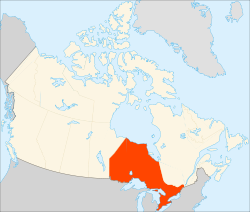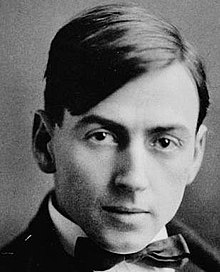Portal:Ontario
The Ontario Portal


Ontario (/ɒnˈtɛərioʊ/ on-TAIR-ee-oh; French: [ɔ̃taʁjo]) is the southernmost province of Canada. Located in Central Canada, Ontario is the country's most populous province. As of the 2021 Canadian census, it is home to 38.5 percent of the country's population, and is the second-largest province by total area (after Quebec). Ontario is Canada's fourth-largest jurisdiction in total area of all the Canadian provinces and territories. It is home to the nation's capital, Ottawa, and its most populous city, Toronto, which is Ontario's provincial capital.
Ontario is bordered by the province of
The great majority of Ontario's population and
Selected article -
Franco-Ontarians (French: Franco-Ontariens or Franco-Ontariennes if female, sometimes known as Ontarois and Ontaroises) are Francophone Canadians that reside in the province of Ontario. Most are French Canadians from Ontario. In 2021, according to the Government of Ontario, there were 650,000 Francophones in the province. The majority of Franco-Ontarians in the province reside in Eastern Ontario, Northeastern Ontario, and Central Ontario, although small francophone communities may be found in other regions of the province.
The first francophones to settle in Ontario did so during the early 17th century, when most of it was part of the Pays d'en Haut region of New France. However, French settlement into the area remained limited until the 19th century. The late 19th century and early 20th century saw attempts by the provincial government to assimilate the Franco-Ontarian population into the anglophone majority with the introduction of regulations that promoted the use of English over French, for example Regulation 17. During the late 1960s and 1970s, because of the Quiet Revolution, Franco-Ontarians established themselves as a distinct cultural identity – having only identified as French Canadians before. Francophone rights were furthered in the 1970s as a result of C'est l'temps, a Franco-Ontarian civil disobedience movement that pressured several provincial departments to adopt bilingual policies.
The provincial government passed the French Language Services Act in 1986 which recognized the French language as a "historic language of Ontario," and as an official language of the province's education system, judiciary, and legislature. However, the Act did not make the French language an official language in its entirety; with other provincial services only made available in French in designated communities and regions with a significant Franco-Ontarian population. (Full article...)General images
-
Ottawa in 2005 (from Southern Ontario)
-
Typical Great Lakes beach (from Southern Ontario)
-
Highway 401 at the Don Valley Parkway in Toronto (from Southern Ontario)
-
Köppen Climate Map of Ontario (from Eastern Ontario)
-
Underground Railroad monument, Windsor (from Southern Ontario)
-
North Bay is often considered to be the "Gateway" to Northern Ontario (from Northern Ontario)
-
Ottawa (from Eastern Ontario)
-
Forests, lakes, and rivers dominate much of the Northern Ontario landscape. (from Northern Ontario)
-
Science North in Sudbury. (from Northern Ontario)
Surrounding areas
Selected biography -
Thomas John Thomson (August 5, 1877 – July 8, 1917) was a Canadian artist active in the early 20th century. During his short career, he produced roughly 400 oil sketches on small wood panels and approximately 50 larger works on canvas. His works consist almost entirely of landscapes, depicting trees, skies, lakes, and rivers. He used broad brush strokes and a liberal application of paint to capture the beauty and colour of the Ontario landscape. Thomson's accidental death by drowning at 39 shortly before the founding of the Group of Seven is seen as a tragedy for Canadian art.
Raised in rural Ontario, Thomson was born into a large family of farmers and displayed no immediate artistic talent. He worked several jobs before attending a business college, eventually developing skills in penmanship and copperplate writing. At the turn of the 20th century, he was employed in Seattle and Toronto as a pen artist at several different photoengraving firms, including Grip Ltd. There he met those who eventually formed the Group of Seven, including J. E. H. MacDonald, Lawren Harris, Frederick Varley, Franklin Carmichael and Arthur Lismer. In May 1912, he visited Algonquin Park—a major public park and forest reservation in Central Ontario—for the first time. It was there that he acquired his first sketching equipment and, following MacDonald's advice, began to capture nature scenes. He became enraptured with the area and repeatedly returned, typically spending his winters in Toronto and the rest of the year in the Park. His earliest paintings were not outstanding technically, but showed a good grasp of composition and colour handling. His later paintings vary in composition and contain vivid colours and thickly applied paint. His later work has had a great influence on Canadian art—paintings such as The Jack Pine and The West Wind have taken a prominent place in the culture of Canada and are some of the country's most iconic works. (Full article...)Selected image
-
Sunset on North Tea Lake in Algonquin Provincial Park, Ontario Canada
-
Waterloo, Ontario taken from the North East corner of the Uptown Parkade
-
Downtown Ottawa is the central area of Ottawa
-
The CN Tower, located in downtown Toronto, Ontario, Canada, is a communications and observation tower standing 553.3 metres (1,815 ft) tall.
-
A view ofMulmur Township, Dufferin County, Ontario
-
A panoramic view of Hamilton, Ontario
-
The Niagara Falls are voluminous waterfalls on the Niagara River, straddling the international border between the Canadian province of Ontario and the U.S. state of New York.
Did you know? -
- ... that Doug McMurdy was the inaugural winner of the Red Tilson Trophy, given to the most outstanding player in the Ontario Hockey League each season?
Related projects and portals
Topics
Categories
Things you can do
- Help expand stub articles: There are numerous stub articles relating to Ontario. You can help by expanding them. See Ontario stubsfor a list. Also, for geographical (places) stubs, refer to:
- Eastern Ontario: Eastern Ontario geography stubs
- Toronto: Toronto geography stubs
- Ottawa: Ottawa stubs - All stubs relating to Ottawa in general
- Northern Ontario: Northern Ontario geography stubs
- Western Ontario: Western Ontario geography stubs
- Golden Horseshoe: Golden Horseshoe geography stubs
Associated Wikimedia -
The following Wikimedia Foundation sister projects provide more on this subject:
-
Commons
Free media repository -
Wikibooks
Free textbooks and manuals -
Wikidata
Free knowledge base -
Wikinews
Free-content news -
Wikiquote
Collection of quotations -
Wikisource
Free-content library -
Wikiversity
Free learning tools -
Wikivoyage
Free travel guide -
Wiktionary
Dictionary and thesaurus








































